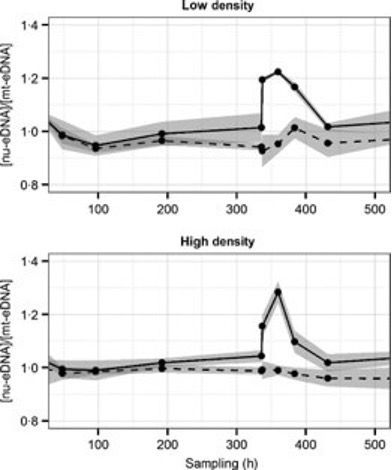Monitoring spawning activity through eDNA
Determining the timing and location of breeding events is important for understanding species’ biology for effective wildlife management. Many aquatic organisms breed through spawning, with males releasing a vast quantity of spermatozoa into the waterway.
eDNA surveys were able to successfully detect a change in the relative abundance of nuclear and mitochondrial DNA in laboratory and field studies, enabling identification of spawning activity in the endangered Macquarie perch, Macquaria australasica. This demonstrates the potential of the eDNA method for detecting reproductive activity in aquatic organisms to increase knowledge of the reproductive biology of elusive species.
The ratios between Macquarie perch nuclear and mitochondrial environmental DNA (eDNA) concentrations over time in treatment tanks. Solid lines represent Experimental Spawning Tanks (EST) while dashed lines represent Experimental Control Tanks (ECT). Ten millilitres of water (ECT) or a mixture of milt and water (EST) were added after 336 h.

Further reading
For more information on this case study, visit besjournals.onlinelibrary.wiley.com/doi/full/10.1111/2041-210X.12709
View our other case studies
Our team has engaged in a wide variety of research projects involving many unique species from Australia and beyond as well as diverse ecosystems. See other case studies of how our research has been applied and the difference it has made for our stakeholders.
EcoDNA acknowledges the Ngunnawal people, traditional custodians of the lands where we are situated. We wish to acknowledge and respect their continuing culture and the contribution they make to the life of Canberra and the region. We also acknowledge all other First Nations Peoples on whose lands we gather.
Email: ecoDNA@canberra.edu.au
Address: Building 7, Level D, University of Canberra, Bruce ACT 2617 Australia

Accreditation number: 21138
Accredited site number: 25428
